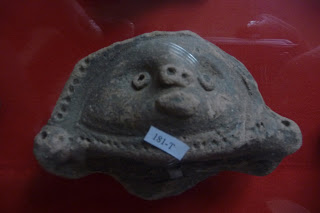 barely pronounce-able to me and, unfortunately, I forgot to it write down.
barely pronounce-able to me and, unfortunately, I forgot to it write down.The building originally served as Santarem's version of the county courthouse, complete with the judge's chambers and a jail. Each room was separate and centered around a courtyard in the middle. The chamber that was most compelling to me contained indigenous artifacts including funerary urns, blow dart weapons, clubs, zoomorphic ceramics, arrowheads and other stone tools. Our guide claimed most of the stone and ceramic objects to be about 6,000 years old. The other articles including the war club are less than 100 years old. Unfortunately there was no provenance information on any of the articles aside from a brief plate identifying Santarem as the location. Regardless of the dearth of information, the exhibit was an incredible "find". In less than one hour I took about 100 photos. If, in this analogy, items can replace words then the objects presented here are haiku.




What's really interesting about these objects is that it appears very little research has been done on them. I was able to find references to only one book (in Portuguese) written in 2002 by an academic at the University of Sao Paulo and one master's thesis (in English) written in 1952 by a student in the U.S. Clearly lower Amazonian-region ceramics are a topic ripe for more research.
So, who were the people likely to have created these objects? Most accounts claim that the original inhabitants of this region were the Tupaius (now known as Tapajoas, like the river). Probably because of its convenient location at the juncture of two massive rivers, the Tupaius people settled a village here. It may have been a seasonal settlement or it may have been permanent one. Although no one questions its antiquity, there is a huge controversy in archaeological and anthropological circles right now about the type of settlement that formed here. Traditionally scholars have thought that the soils of the Amazon were too fragile to sustain anything more than mobile and small-sized hunter/gatherer communities. The main advocate for this line of thinking is a woman named Betty Meggers who has done quite a bit of research in this region as well as on an island closer to Belem. The scholars who identify with Meggers' theory are known as inventionists, and are generally considered mainstream academics. The basic idea behind their theory is that the peopling of the Americas occured gradually between 10,000 BCE (Before Common Era) - 3,000 BCE as a result of migrants walking across the frozen ice sheets between Siberia and Alaska during the last Ice Age. Anyone who has studied anthropology in the last 100 years has been taught this theory of human migration. The inventionists claim that the peopling of South America took place later than the peopling of North America simply because it took about 7,000 years for the migrants to move this far south.
On the other side of the controversy are the diffusionists. They are academics who are considered outside the mainstream because their ideas are not in line with the traditional theories about human migration. The diffusionists suggest that there may have been intentional contact between Pacific and Atlantic civilizations between 7,000-3,000 BCE. Basically diffusionists challenge traditional ideas about how and when the Americas (particularly South America) were peopled. One of the more prominent academics who could be called a diffusionist and who works in this region is Anna Roosevelt (yes, a distant relative of the two U.S. presidents). About 10 years ago she discovered petroglyphs in some caves across the river from Santarem. After performing over 50 carbon-14 dating tests on the paintings and other objects found there, she determined that humans inhabited this region as early as 10,000 BCE. Clearly this discovery throws the traditional theories on their ear.
Another important element about Roosevelt's discoveries at Caverna da Pedra Pintada has to do with the type of society the diffusionists believe early South Americans constructed. In short, Roosevelt postulates that the social formation consisted of "large, proto-state . . . interfluve forest societies" (Nugent). They weren't mobile, nor were they small according to Roosevelt. This, then, leads to another controversy about the type of soil in the region and the soil's ability to sustain a large-scale community.
While there are more questions than answers about the people who inhabited this part of the lower Amazon, one thing is for sure. The controversy about human migration, points of contact between civilizations, social formation and soil stability point to a redefining of our understanding of pre-historic America. In short, the story has not been fully told.
Most of the information on this topic can be found at http://www.theatlantic.com/issues/2000/01/001stengel.htm , http://www.theatlantic.com/doc/200203/mann , and http://www.sciencemag.org/cgi/content/full/275/5308/1948 .
The citation came from Nugent, Stephan. "The Amazon on Display: Unknown Amazon: Culture in Nature in Ancient Brazil." British Museum exhibit. June 2002. Anthropology Today. Vol 18, No 3, pp 21-22.





No comments:
Post a Comment